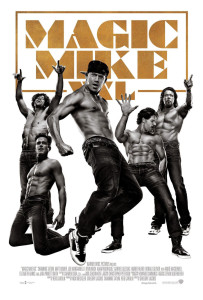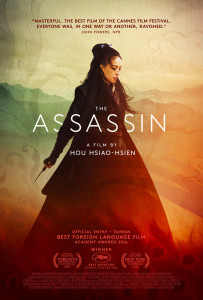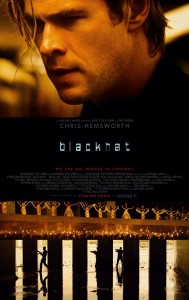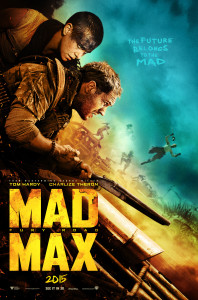A typical year spent traversing the cinematic landscape results in straddling some kind of line: one foot confidently marches off into the future while the other remains firmly planted in the past. Innovation is an organic byproduct of any artform, but so is adherence to a certain classicism, and 2015 was particularly emblematic of this. On the one hand you have Steven Spielberg, delivering what has to be his most Spielbergian film in ages with Bridge of Spies, a subtly political but mostly humanist tale of ordinary people caught in extraordinary circumstances. On the other hand, you have Sean S. Baker, whose Tangerine, a hilarious and emotionally resonant day-in-the-life of two transgender sex workers, was filmed entirely on a trio of iPhone 5s. Predictably then, and naturally, the majority of films fall somewhere in between, themselves evincing both the future and the past of the medium. George Miller shook up the Hollywood narrative with Mad Max: Fury Road, a wholly invigorated and technologically-reliant entry into a decades-old franchise; Todd Haynes’s Carol employed a largely classicist style in its story of a socially-condemned lesbian love affair in the 1950s; and a pair of westerns, Quentin Tarantino’s The Hateful Eight and S. Craig Zhaler’s Bone Tomahawk, demonstrated that reverence and innovation can exist, and even thrive, within the same space. So yeah, 2015 was typical, but in all the living, breathing, budding ways that prove that cinema is alive and changing. Luke Gorham
10. Recombinant of the Eurocore exploitation films of Jess Franco (She Killed in Ecstacy, or the female-gaze minds capes of Vampyros Lesbos), the psychic sparring and elegant, nuanced cruelty of Fassbinder (Petra Von Kant or Martha), and Baby Jane-style arthouse psychothrillers like Morgiana, Peter Strickland‘s ravishing film The Duke of Burgundy is 2015’s greatest romance—no mean trick in a year with Carol—and all with no men, no outsider morality to antagonize, no nudity, and almost no on-screen sex. As the relationship between young sub Evelyn (Chiara D’anna) and her older dominant lover Cynthia (Sidse Babbett Knudsen) deteriorates from a combination of unfulfilled sexual appetites, a lack of communication, and sheer fatigue, cracks begin to appear in their carefully manicured and impeccably styled world until they retreat into their respective obsessions (lepidoptery and watersports, naturally). No other recent film has so perfectly deployed a pristine facsimile of bygone cinematic esoterica, and maybe none ever has transcended that to tell a simple story about the simultaneous perils and rewards of giving yourself, emotionally and physically, to another person out of love. Matt Lynch
9. It’s an unfortunate development that saw Sicario released into American theaters amidst a surfeit of nonsensical campaign rhetoric from Donald Trump that sought to demonize our neighbor to the south. And while the real tragedy of this narrative is that a legitimate presidential candidate soft-balling cartoonish hate speech can find a sizable demographic clambering for it, the lower stakes misfortune is that a subset of moviegoers may misappropriate Sicario‘s narrative and miss out on the considerable technical craft and the slow-burn brilliance it has to offer. Functionally a horror film where every musical cue and otherwise unassuming establishing shot takes on increasing significance as the ratcheted tension impossibly continues to build, Sicario brazenly offers us the most abstract of boogeymen: the loss of ignorance. As the film’s nominal though impotent heroine (Emily Blunt) comes to find out, sometimes the act of pulling back a curtain represents the only real villain, something Denis Villeneuve and company depict with terribly bleak beauty. Luke Gorham
8. InRO contributor Peter Labuza has elsewhere ambivalently described Horse Money as a series of #OnePerfectShots, the Twitter account that reduces moments of ingenious film technique into pretty postcards. Indeed, Pedro Costa’s latest entry in his ongoing project about the troubled, poverty-stricken lives of Cape Verdean immigrants in modern Portugal—still quaking from the 1970s revolution—offers some of 2015’s most striking images: shadowy, harshly angled, and illuminating, a bewitching texture on every wall. But the film’s greatness and tragedy are derived from the way Costa destabilizes time and space to immerse us in the scrambled subconscious of Ventura (playing himself)—or José Tavares Borges, the identity he sometimes assumes. Each image and sound presented asks us to reexamine our spatial positioning and the existential negotiations of our lead character, making Horse Money stand out in Costa’s oeuvre for its otherworldly (rather than mundane) approach to an urban, decaying environment. Costa’s simultaneously cramped and expansive 1:33 frame, meanwhile, perfectly evokes one man’s wandering, aching psyche. Charles Lyons-Burt
7. Forget it being a film that acknowledges female pleasure, uses cinematography to create racial harmony, and never once hints at gay panic: Magic Mike XXL is a movie musical that harkens all the way back to Busby Berkeley’s “let’s put on a show” ethos of pure joy. The eclectic cast creates their fantasies through a road trip, entertaining women with acrobatic movements and perfect abs. Former Steven Soderbergh-assistant Gregory Jacobs takes the directing reigns by abandoning the strained-seriousness of the first film and instead celebrating the bliss of movement and freedom in his relaxed compositions, which show off dance numbers through surprises in cinematography and production design, as well as Jada Pinkett-Smith’s booming voice telling us to indulge our desires instead of holding them back. “We can be healers,” Donald Glover’s character notes. This is a movie where the potential to bring happiness is not an absolute—simply a possibility in this escape from reality, which is to say, why we go to the movies. Peter Labuza
6. While David Robert Mitchell was able to eerily capture the solitude of youth in his contemplative debut feature, The Myth of the American Sleepover, he has altered that aim some to better suit a horror film environment with his sophomore effort, It Follows, an admittedly bonkers tale of teenagers trading assassins through sexual intercourse. Mitchell has crafted a genuinely unique entry into the horror genre here by using a traditional stalker setup as a visual metaphor for concerns about sexual health, critiquing attitudes towards promiscuity, while also delivering thrills to a target audience dominated by teens themselves. Impressively, he recognizes that horror is something intangible, or even illogical, and that true fear derives from being forced to rethink something previously taken for granted. After all, what would happen if we went back to an era where sex was treated as more of a chore than a treat? Now that’s a scary thought. Calum Reed
5. Michael B. Jordan’s Adonis Johnson furiously grapples with the legacy of his late father, Rocky III‘s Apollo Creed, while seeking out tutelage from Sylvester Stallone’s aging trainer back in Philly, while also courting a local musician played by Tessa Thompson. Bodies of both young and old begin to erode, causing time to feel precious and in minimal supply, especially considered in the context of these tender relationships. Seemingly announcing itself as a chip off the old Rocky block, Ryan Coogler’s passion project-cum-dazzling sophomore effort is linked and beholden to its franchise in ways one might have easily anticipated. Legacy is paramount here, but the larger revelation found time and again in this populist Hollywood powerhouse lies not only in Coogler’s vast improvement as a filmmaker since Fruitvale Station, but also in his film’s confident ability to pivot between moments of glowing familiarity, unexpected vulnerability, and towering emotion. With its many and varied visceral thrills, the unabashedly progressive Creed cunningly transcends being a sturdy crowd-pleaser and becomes something closer to great art. Ty Landis
4. The most romantic film of the year ignites when, towards the end of its in medias res opening, Cate Blanchett’s Carol clasps the shoulder of Rooney Mara’s Therese. From there, flashing back and eventually forward, Todd Haynes utilizes a cinema of looks and touches to build his film’s central relationship. Carol represents a sort of culmination for Haynes as a director of explicitly queer film, a thematic companion to Far from Heaven with the mise-en-scene of Safe. As in the latter, Haynes surrounds his stars with the neatly arranged but obtrusive fittings of the domestic, enclosing them in manmade space, trapped by the men who are framed and written as obstacles to their relationship. But when Carol and Therese escape to each other, there’s magic in their eyes and longing on their tongues, as performed with aching grace by Blanchett and Mara. It’s never long until an obstruction once again enters frame, but reunion becomes as inevitable as separation. Chris Mello
3. Shot in the contrast-heavy black-and-white chosen for the film’s economical prologue, The Assassin opens on two donkeys tied to a tree, a slow pan revealing their masters looking off in the opposite direction. It’s an image that calls attention to the subservient first, and the ambivalence of the powerful second, a historical consideration that transcends period trappings, much like the etymological significance of the two jade amulets The Assassin‘s two principals possess. Most impressively, director Hou Hsiao-hsien and cinematographer Mark Lee Ping Bin use the expansive canvas of the film’s mis-en-scene to externalize the philosophy of its characters: the billowing fog and jutting landscapes that frame a duplicitous teacher, the low rumble of percussion that fills an Imperial court’s austere crimson and gold halls, and most important, the tranquil stillness and soft-focus of the rural villages, striving to exist outside all of the film’s politically-charged conflict. Sam C. Mac
2. One of the biggest commercial failures of the year, Michael Mann’s Blackhat was criminally underseen by moviegoers and eviscerated by critics—which is a shame, since there is no one right now making images like Mann. Continuing his fascination with digital cinematography, Mann makes no efforts to pretend that digital and film are the same medium—instead he embraces the washed-out daylight, the crisp, crystal clear nighttime photography, painting the screen with fuzzy smears and deep focus shots of expansive skies. A destroyed nuclear reactor becomes a graveyard, a fine layer of dust floating in the air. Underground tunnels become warzones, and the neon buzz of Hong Kong—all reds and greens and blues—pop against hazy gray. From the opening images of the insides of a computer, corrupted by a lone bit of code, to the flow of parading bodies that climax the film, Mann has created a visual analogue for the movement of humans, turning into bits of digital information. It’s a profound statement for the 21st Century—we are all digital currency, like it or not. Daniel Gorman
1. Mad Max: Fury Road is, gloriously, what happens when a 70 year-old gets to make the movie he’s been carrying around in his head for decades. It’s an unhinged feat of moviemaking on a massive scale that possesses mythological purity, seeming to spring fully-formed from the mind of its creator. Everywhere a viewer looks, they find familiar fragments of a ruined world—one of my favorite bits of Colin Gibson’s ingenious production design is a shoe-store foot measuring device repurposed as the gas pedal on Furiosa’s War Rig. George Miller has the vision, but his collaborators make it indelible—his editor Margaret Sixel cuts action sequences not along the lines of choreography or coverage but to the characters’ placement, keeping a viewer aware of where the heroes are, what they’re doing, and what the next threat might be down the line as soon as it rears its head. This is an ecstatic vision of what all franchise reboots could be: Use an established character to get the studio backing and the budget to make one’s wildest dreams a reality, then have them step aside to watch as the new hero, the one we need right now, ascends. Alex Engquist











